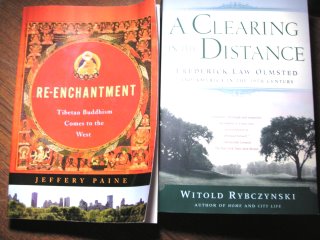I suspect I looked not so much like Helen MIran as Queen Elizabeth as played by Miran. [I.e., a bit dowdy and dissatisfied -- I was, in fact tired.] For a long time I've believed that a number of facial templates exist. It's not unusual for someone to say, "you remind me of ..." "Do you know you look at a lot like ...?" it's usually a secondary actress -- Miran is probably the star-iest ... but I suspect, as I said it's QE-2 she meant who is not exactly a glamorous woman people aspire to look like. I'm never told I look like the sexy blond. No one ever said, "You look a lot like Sharon Stone." Until I let my hair go white it was usually the brunette 'best friend." character. ... Well, it could be worse, it could be Phyllis Diller or Lucille Ball.
What I've been reading:

I've just finished reading Jeffrey Paine's RE-ENCHANTMENT, which is a breezy, quick read that covers the history of America's awareness of Tibetan Buddhism, and of Tibet. I've researched the subject on my own over at least the last ten years, since I went to Tibet in 1995. I actually bought the book, which I found at the Metropolitan Museum's shop because is has a chapter [only 4 pages] on Theos Bernard, the Tibetan traveler who inspired my interest in the first place. No other book I've come across even mentioned him. Various facts were wrong -- but, I think because the information was not available. At times I was put off by the cursory way Paine described people [other than Bernard, I know a lot about David-Neel and about Tenzin Palmo and am generally conversant on the subject]. But Paine seems to have a grasp of what Buddhism actually is beneath the layers of Tibetan ritual and he takes seriously this form of Buddhism's contribution to American society and to world politics.
Besides Paine, I'm reading the biography of Frederick Law Olmstead who I admire enormously for planning that jewel in the heart of Manhattan that I love very much, Central Park. The man is fascinating; the book reads easily even though there are a lot of facts thrown in we really don't need [the families of many young woman Olmstead might have but didn't marry. The researcher hates to waste the notes he took.] Olmstead designed many, many other wonderful public spaces, I'm fascinated to find out just how much his ideas -- i.e., British ideas -- of natural beauty have affected and infected American life.

Finally, I'm back to Bea Ogelby's book of butterflies. I used it for the 35 or 40 post cards I made and for the "Migrating Monarchs"wall quilt, and I thought I was entirely finished with the book. But after a meeting yesterday at the guild about selling items at a members' boutique at the upcoming [March] show, I suddenly thought I'd like to make more butterfly items, post card size but matted so they can be framed and used as occasional pieces in decor. Because I am so attracted to butterflies right now, I can't help thinking others will be too. Of course, that could be entirely wrong. In a way it doesn't matter because I feel like continuing to make butterflies. It's not out of my system. Something about them nags at my psyche right now. Why not give in? I might make a little money; and I'll enjoy making them, in any case.







No comments :
Post a Comment